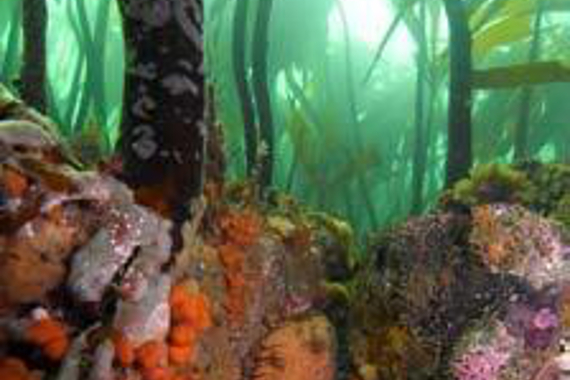
Restoring kelp in Gwaii Haanas National Marine Conservation Area Reserve and Haida Heritage Site
Chiixuu Tll iinasdll – Nurturing seafood to grow
What’s the issue?

Nearly 200 years ago, kuu (sea otters) disappeared from Gwaii Haanas as a result of the maritime fur trade, and coastal ocean ecosystems in the area have experienced a cascade of change ever since. The reason is that sea otter are keystone predators – voracious consumers of marine invertebrates like sea urchin, crab and abalone. Without otters keeping populations in check, spiny sea urchins proliferated, and the cascade began. Urchins in turn began to graze down the rich kelp forests on which species like the endangered northern abalone and many rockfishes (yelloweye, bocaccio, canary, quillback) depend. Kelp forests declined in quantity and quality. In some places the seafloor is now barren, reminiscent of a clear-cut forest, and no longer able to support a diverse marine ecosystem.
What’s our approach?
- Work with the Council of the Haida Nation, Fisheries and Oceans Canada, and the Pacific Urchin Harvesters Association to plan and implement a restoration project that mimics sea otter predation.
- Reduce the density of sea urchins by at least 75 percent, covering a total area of 20 hectares of lower intertidal and shallow subtidal seafloor.
- Provide training so Haida Fisheries Program divers can continue to build capacity to conduct kelp forest monitoring; encourage participation of Haida commercial divers to harvest urchin.
- In the years following sea urchin reduction, work with fishing partners to maintain low urchin numbers, allowing kelp forests to recover.
- Provide Haida and local communities with opportunities to access sea urchin for food; discuss with Haida community leaders the distribution of harvested traditional foods: guuding.ngaay (red urchin) and styuu (green urchin).
What’s been accomplished?
- Developed and implemented a monitoring protocol to assess the effectiveness of the restoration work; collected one year of pre-restoration baseline data (2017).
- Began collaborative research with Florida State University to investigate changes in kelp forest community and species population dynamics, including changes in abalone and sea urchin diet.
- Initiated plans to mentor Haida Fisheries Program divers in kelp forest community surveys.
- Began drafting a communications plan and visitor experience materials to educate and inspire Canadians about marine restoration.
Related links
- Igniting restoration
- Two pines in decline
- Conserving an alpine enigma
- Rescue the fescue
- Historic homecoming
- Wildlife crossings
- Going with the flow
- Propagating success
- Listening to the sea, looking to the future
- Ecosystem on the edge
- Keeping dunes dynamic
- Wild about wolves
- Llgaay gwii sdiihlda, or restoring balance
- Date modified :